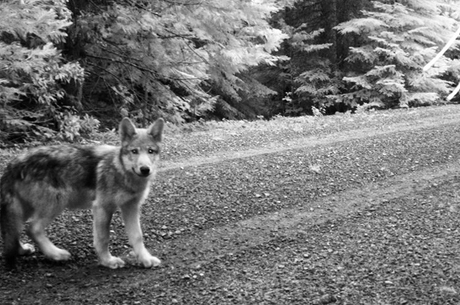
One of wolf OR-7′s pups, born this summer in southwestern Oregon.
by USFW
by Matt Weiser / High Country News
California’s fall from grace hit me in 2007, at around 9,000 feet in the Sierra Nevada. A friend and I were returning from a backpacking trip, still about a mile-and-a-half deep in the Mokelumne Wilderness, when a stroller rattled around a bend in the trail, its tiny passenger jabbering away as Dad navigated the rocky ground.
In the next half mile, we passed several dozen senior citizens, one or two dragging wheeled oxygen bottles. They were enjoying a brief side-trip on a casino run; their tour bus waited patiently at the trailhead.
These folks were experiencing a nature high as real as my own. But I felt like I had dropped from timberline into a shopping mall. And it struck me: California had run out of remoteness. Neither man nor beast would ever again find respite from the pulse and clatter of civilization, not even in wilderness.
Which is why I was as stunned as anyone on Dec. 28, 2011, when OR-7 trotted over from Oregon to become the first wild gray wolf in California in 87 years.
The 2-year-old male – named for being the seventh wolf ever radio-collared in Oregon – was a product of the federal reintroduction effort that began in the Northern Rockies in 1995. OR-7 had left his home pack in northeast Oregon and traveled the entire length of that state to seek a mate and claim his own turf.
For some reason, he came to California, a state with 38 million inhabitants – more people than all the other Western states combined.
OR-7 spent 15 months traveling the state’s northeast quadrant, roaming more than 3,000 miles on a crazy-quilt course recorded by his GPS collar. He explored at least five national forests, crossed numerous highways, and came within howling distance of busy Interstate 5 near Red Bluff at least twice.
Yet nobody ever saw him. This is no small feat: California in 2012 had an average population density of 244 people per square mile, the highest in the West. The runner-up, Washington, has a density of less than half that.
The public reaction was a mixture of elation and anxiety, familiar from wolf reintroduction in the Rockies. But there was more to it: a sense that we were part of something miraculous. No matter our politics or lifestyle, we were astounded that our crowded state could still interest a wolf.
As OR-7 wandered, we wondered, and demanded information. The Department of Fish and Wildlife posted daily updates on its website (minus precise location data, to protect the wolf). Tracking his course became as habitual as checking the weather. Media stories covered the wolf’s epic journey, his chances of finding a mate, the policy implications of his arrival.
The newspaper stories I wrote about OR-7 were among the most widely read and appreciated in my 25 years covering California environmental issues. Readers of all political bents thanked me. They even renewed my faith that print newspapers still mattered in a digital era: People were clipping and saving the stories, passing them around in classrooms and mailing them to relatives.
“I think it’s just more fascinating than anything,” Brian Dahle, then a county supervisor in conservative Lassen County, said in January 2012. “It actually came close to my own farm. It’s amazing how far the animal has traveled.”
One acquaintance wrote a poem about OR-7, dedicating it to me just for covering the story. Another reader created an hour-long dance performance inspired by OR-7′s travels. At the premier, he showed me a binder packed with clippings of my OR-7 stories, and thanked me from the stage for covering the saga.
All this was a little uncomfortable. As a journalist, I was trained to remain detached to preserve my objectivity. I had been careful to let my sources do the emoting about OR-7, keeping my own feelings in check.
But something momentous had happened to California. I eventually realized that it affected me as well. If this icon of the American wild was so interested in our state, perhaps I had been hasty back at that trailhead. Maybe California still holds solitude – if you know how to find it.
OR-7 crossed back into Oregon in March 2013, then settled into a forested region between Klamath Falls and Medford. This June, officials confirmed he had found a mate, her origins unknown. They’re raising at least three pups, which have been photographed by remote camera.
The young members of this new pack will eventually disperse, and may even follow their father’s scent trail back to California. If they do, state biologists say there’s enough habitat for a few.
OR-7 reminded us that, despite our 244 people per square mile, there is still something wild about California. Now there is reason to think it could be wilder still.
Matt Weiser covers environmental issues for the Sacramento Bee newspaper.

